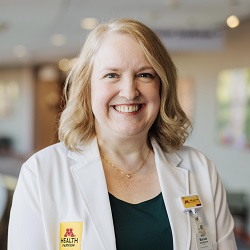A helping hand for hospitalists
One program created a new physician role to support other colleagues in their daily tasks.
Background
In early 2021, hospitalist leaders at Massachusetts General Hospital (MGH) were looking for some way to help with “the pure exhaustion of inpatient teams after the second wave of COVID,” said Melissa L.P. Mattison, MD, FACP. It occurred to the hospitalists, of whom Dr. Mattison is chief, that one aspect of nurses' system of care might also be helpful for physicians.
“Every day in pretty much every hospital in America, on a general care unit, there's a resource nurse who typically has a lighter assignment or no assignment in terms of patients. They are available to help troubleshoot challenges in real time on the whole unit. If there's a patient that needs extra care—has a rapid response or a code or something—there's an extra nurse available on the floor to help,” said Dr. Mattison. “We decided to borrow this idea and create a new role.”
How it works

They called the new physician role the SafeTy And Resource (STAR) clinician. Starting in March 2021, for a six-week pilot, the group reassigned a hospitalist who had been doing admissions from the ED boarder service to be the STAR, 8 a.m. to 6 p.m., seven days a week.
“Your job is to make sure your colleagues have the best day possible,” explained Amy W. Baughman, MD, MPH, one of the hospitalists leading the project. That entails attending all rapid responses and codes for hospital medicine patients, reviewing records of unstable patients, and volunteering to help other hospitalists with anything that will support their care for patients.
“That might be a task that's intensely important and very time-consuming, but also very unglamorous,” said Dr. Baughman. “For example, getting that medical record, calling the pharmacist, or confirming a methadone dose. … We have a lot of tasks that are not particularly complicated, but super painful, and get in the way of doing complex care.”
STAR clinicians are also called upon to provide additional clinical and hospital system expertise, and for that reason, all of them have at least three years of local experience. “You would never be assigned the role your first month at MGH,” said Dr. Mattison. “We have anywhere between 150 and 230 patients on our service at any given time, so we know that every single day, things will happen unpredictably across that service. It's really nice to be able to call somebody and say, ‘Hey, I just want to talk through this case with you.’”
Results
To assess the effects, the 17 hospitalists who worked as a STAR during the first six weeks and 43 of the clinicians they assisted were surveyed, with results published by the Journal of Hospital Medicine on Dec. 9, 2024. On average, the STARs reported assisting four colleagues per day and contributing to the care of five patients per day. Their most frequent tasks were covering pagers, rounding on stable patients, assisting with rapid response or unstable patients, helping with documentation, communicating with teams or families, and assisting with ED boarding care.
Most (88%) of the STAR clinicians reported that they thought care was improved by their work. Of the clinicians they worked with, 92% thought the STARs were helpful, 90% said they decreased stress, and 78% said the intervention helped them finish their shifts on time.
“We had many very thoughtful testimonials,” said Dr. Baughman. “Examples of how care was improved—it was more efficient and timely, the medical management more appropriate, care coordination was better, and a lot of efficiencies in terms of being able to advance care, which makes sense. Instead of one person, you're two people, so you're able to do more.”
Challenges
It did take a little work initially to help hospitalists understand what the STAR clinicians were able to do for them, explained William C. Hillmann, MD, another hospitalist leader of the project. “When you would go to them and say, ‘What can I help with?’ people would not really know what to say, because hospitalists are problem-solvers. We're used to figuring it out,” he said.
STAR clinicians were trained to make their offers of assistance specific, such as “Do you want me to travel with this patient while they go get their stat imaging?” Another solution was to place the potential help in the middle of the action. “We gave the STAR a dedicated workspace, right in the center of our bullpen, and it's impossible to walk down the hallway to the computers without walking past the desk,” said Dr. Hillmann.
Nurses were also educated about the role, said Dr. Mattison. “We made sure that the nursing leadership on all the floors knew who they were, and we encouraged them, if they saw a physician struggling, to call the STAR.”
Dr. Hillmann noted that there are a few hospitalists who aren't as into collaboration and prefer not to work as or with the STAR, and that's OK. “[That's] the sort that [feel] when I'm taking care of somebody, I need to own it. … Those people self-identified themselves pretty quickly and said, ‘Maybe I'm not the best fit for this.’”
Lessons learned
Getting such a position approved by hospital administration might seem like another potential challenge for others looking to copy the model, but Dr. Mattison is convinced that the STAR provides a return on investment.
“If you have a team that is struggling, because they have a patient that has an acute event or they have an outside-hospital transfer that has six-inch-thick hospital records that need to be combed through, things are going to slow down on their list. They're not going to be advancing the care of their other patients. You're increasing length of stay of other patients. So I think it actually helps the institution. It helps patient throughput, and it helps the team's morale,” she said.
Dr. Baughman agreed, pointing out the financial benefits of hospitalist satisfaction. “Your retention is better,” she said. “Those days that are career-ending—‘That was the worst day of my life and I just can't’—I believe that we have fewer of those.”
Reluctant administrators may be eased into the idea if the role is pitched as a partial, as-needed one, Dr. Mattison said. “We did this actually years ago with our procedure service, as well. We were told there weren't enough procedures to keep somebody busy. We said, ‘OK, fine, they'll do admissions when they're not doing procedures.’” The STAR clinician currently supervises and assists MGH residents and advanced practice providers (APPs) with admissions.
Next steps
Given the positive response, the STARs stayed on after the six-week pilot. Their role was also subsequently expanded to cover nights, and the APPs got their own STAR.
“It's a very different job description than the physician STAR role,” explained Dr. Mattison. “We have about 25 APPs that started in the past year, and many of them are fresh out of school … Having an APP STAR available to walk them through things and answer their questions has been really helpful, because some of the APPs, especially the brand-new ones, were reluctant to burden a physician with some of their questions, but they're happy to ask a fellow APP.”
Words of wisdom
Dr. Baughman hopes that the program will serve as an example for other hospital medicine programs of how to better support physicians. “We've showed what's possible,” she said. “It's not a unicorn fantasy idea. It's actually a real role. You can implement it.”



